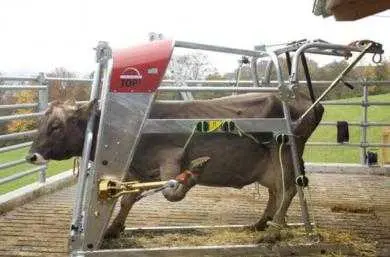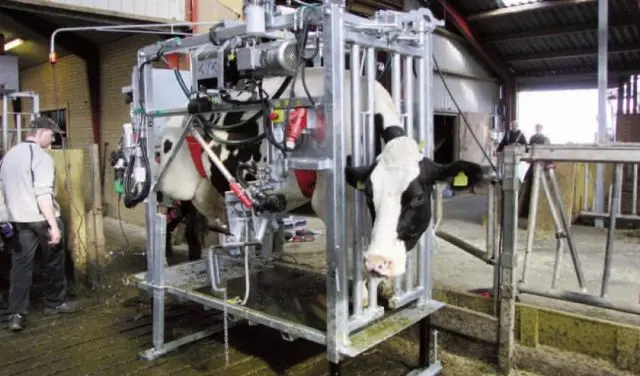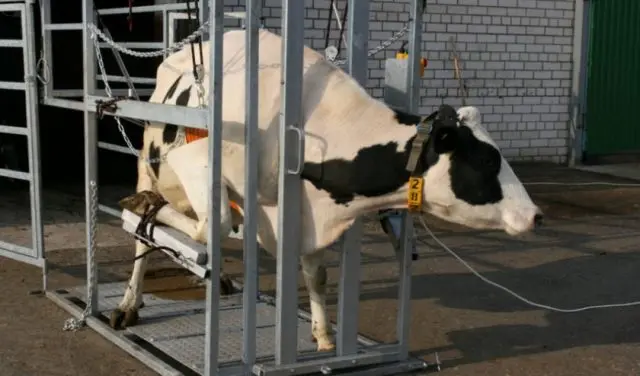Contents
The machine for processing the hooves of cattle is a device in the form of a metal frame or box with a mechanism that limits the activity of the animal. A factory made product is expensive. In order to save money, livestock breeders make splits on their own. Machines are used not only in the processing of hooves. The device helps to carry out examinations, treatment of cows.
What are the machines for fixing cattle
Machine tools for cattle from different manufacturers differ in design features. Regardless of the manufacturing technology used, all splits function according to the same principle, they are placed inside the barn. Hoof trimming machines are:
- collapsible;
- easel;
- mechanical;
- with electric drive for front and rear legs;
- hydraulic;
- wheeled.
The last option is convenient in terms of movement. It is convenient to roll the machine due to the presence of powerful wheels.
Almost all factory-made machines are a rectangular structure made of metal frames. Approximate dimensions:
- length – 2,5 m;
- width – 1,1 m;
- height – 2 m.
A device for processing hooves is made of metal. The protective coating is a galvanized layer or paint. The machine has no sharp corners, protrusions that can injure the animal during the procedure. The locking mechanism is chains with leather straps.
Learn more about the machines on the video
Pros and cons of machines for cattle hooves

According to the rules of cattle veterinary medicine, hoof treatment is a mandatory measure aimed at improving the health of animals. Without machines it is impossible to perform the procedure, and this is their main advantage. Other benefits include:
- most machines are compact, have transport wheels;
- convenient fixation mechanism does not squeeze the internal organs of the animal during hoof trimming;
- the split simplifies the procedure without exposing the cow to stress, protects the operator from being hit by hooves;
- machines help to perform other veterinary activities: trimming of horns, examination, medical care;
- the split allows one person to perform the hoof trimming procedure;
- up to 100 animals can be served on one machine per day.
Disadvantages are observed in the design of some models:
- a light split with poor support is unstable, during hoof trimming it can tip over, which will result in injury to the cow and operator;
- due to improperly positioned belts, poor fixation occurs, the animal experiences discomfort.
However, disadvantages are usually observed in home-made designs and cheap machines of unknown origin.
In a good machine, the animal behaves calmly due to the presence of a convenient support. It is optimal to give preference to vertical models, since lateral fixation is dangerous for pregnant cows. In a high-quality split, the support is located on the same level with the floor. High descent is not allowed. The cow on it slides, falls, is injured.
How to choose the right machine

In order to optimally choose the right split for cattle, you first need to find the exact answer to a number of questions:
- For how many livestock is the device designed.
- How many cows per day to process.
- How many operators.
- The machine will be used to service beef, dairy cows or a universal model is needed.
- The split is only needed for hoof trimming or other procedures.
- Which type of machine is more suitable: mechanical, hydraulic, on wheels, with electric drive.
- How much money the owner is willing to invest to buy a split
- Is the owner ready to incur large expenses for the purchase of a device that provides increased safety for cattle and the operator, comfortable working conditions.
Finding answers to questions, the choice of model will be greatly simplified.
Cattle hoof treatment rules

The hard stratum corneum protects the animal’s hooves from damage. However, over time, it develops into thick growths. If the stratum corneum is not cut off in time, the cow begins to experience pain while walking. The animal limps and falls.
The basic rules for hoof trimming are:
- The first procedure is performed under the guidance of an experienced specialist.
- The frequency of pruning is determined by the method of keeping: stall – three times a year, loose – two times a year.
- The day before the procedure, cattle are kept on a damp bedding. From moisture, the stratum corneum of the hooves becomes softer.
- The instrument is disinfected.
- After fixation, the cows are convinced that she is comfortable. Check the tightness of the belts. If the cow is agitated, it is recommended to inject a sedative.
- On the day of the procedure, KRS provide silence, tranquility. Loud exclamations, noise will cause stress.
- Before trimming, the hooves are washed from dirt, treated with an antiseptic solution, and checked for inflammation.
- Trimming of the stratum corneum is carried out carefully so as not to damage the hooves. Grind protruding sharp edges.
Before proceeding with the maintenance of cattle, the animal must be driven into the machine. The best option is to install it opposite the entrance doors of the barn. The animal itself will calmly enter the machine. The door is closed behind the cow, and the body parts are fixed with straps. The head must fall into a special recess.
In private courtyards, a stationary machine is usually located where there is space. The owner takes the cow out of the barn on a leash, calmly leads to the place of the procedure. The animal is soothed with gentle persuasion.
The cattle hoof trimming sequence consists of the following steps:
- The driven animal into the split is securely fixed with straps. Perform cleaning, inspection of hooves, take measurements.
- The hooves of the front legs of the cattle are cleaned first. The cut is done carefully, moving along the hoof. Remove all gray growth until a white hard surface appears.
- Stepping back from the edge of the sole about 3 mm, forceps are placed. The device will help to clean the surface to the same thickness using a cutter.
- The protruding bristles of wool are cut off with scissors. Sharp protrusions are processed with a file. A hoof is considered properly cleaned if the sole lies flat on a flat surface, such as a knife blade.
After trimming, disinfecting the hooves is performed. The new surface is prone to infection. To protect the white layer, lubricate with a solution of copper sulfate or use a potent agent – formaldehyde, then rinse with water pressure.
How to make a do-it-yourself machine for processing cattle hooves

Factory-made machines are expensive. Buying them for an owner who has 1-3 cows is not profitable. The device is made independently. A solid construction will be obtained if it is welded from metal pipes. As a temporary split, a fixture assembled from wooden poles and boards will serve.
From the tool you will need:
- a hacksaw on wood;
- Boer;
- screwdriver;
- a hammer.
To fix the wooden elements, nails and self-tapping screws are prepared.
Construction assembly:
- 4 poles 1,7 m long and 2 poles 0,7 m long are sawn from round timber or wooden beams.
- On the site mark the place of installation of the pillars. Holes are drilled with a drill.
- Long pillars are placed along the contour of the quadrangle. They form the basis of the structure. Small poles are placed along the edge. The legs of the cattle will be fixed to them. Small pillars are removed from the base of the quadrangle by about 0,5 m. The depth of immersion in the ground of all supports is 0,2 m.
- Boards are sewn onto the installed poles. From two sides below, struts are nailed crosswise to prevent loosening of the structure. A crossbar is attached to two small supports.
The chain to hold the animal and the fixing belts during trimming are thrown onto the pillars of a home-made machine.
Conclusion
The machine for processing cattle hooves must be reliable. If a decision is made to make it yourself, then it is advisable to give preference to a steel structure, but it will cost more than a wooden counterpart.









